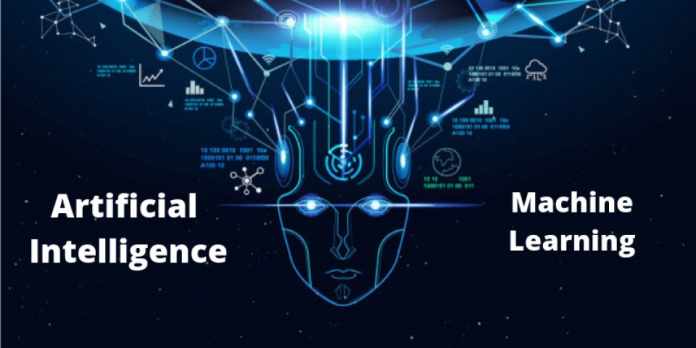Artificial Intelligence (AI) and Machine Learning (ML) are two popular and modern technologies utilized to create smart systems. Although these two technologies are connected and frequently used as synonyms, the two fields remain separate in different instances. However, in its conjunction, the most current advancements in AI and ML have been found.
According to the World Economic Forum (WEF) report, artificial intelligence can produce nearly 58 million jobs in the following years. It is projected that by 2025 AI will become a $60 billion industry!
Enroll now for Post Graduate Program in AI and Machine Learning course with top industry-recognized. This article describes certain aspects on which you can distinguish these two terms.
What is Artificial Intelligence?
Artificial intelligence is a computer science field that produces a computer system capable of imitating human intelligence. It consists of two terms, “artificial” and “intelligence,” meaning “human-made thinking power.” We can therefore define artificial intelligence as a method to develop smart systems that replicate human intelligence.
Instead of using such Algorithms as they can work with their intelligence, the artificial intelligence system does not require pre-programming. Instead, it includes machine learning algorithms, such as reinforcement learning algorithms and deep learning neural networks.
Employment in AI has increased considerably in recent years and continues to grow at an accelerating rate. Fifty-seven percent of Indian organizations expect the right talent to match the market sentiment. On average, the salaries of candidates who successfully transferred to AI roles rose by 60-70 percent.
What is Machine Learning?
Machine learning is an artificial intelligence application (AI) that offers systems that can learn and develop automatically without being explicitly designed. The primary objective is to enable computers to learn autonomously and change their activities without the help of human beings.
But the text is viewed as a sequence of keywords using classical algorithms of machine learning; alternatively, a semantic analysis-based approach imitates a human ability to interpret text’s meaning.
Machine learning enables extensive data analysis. While generally providing faster and more detailed findings to discover, you may also require good possibilities or dangerous threats, more significant time and money to train them properly.
Differences
- Artificial intelligence is a computer-based technique to emulate human activities.
- Machine learning is an AI subclass that helps a device learn from past data without a particular programming process.
- The goal of AI is to create an intelligent computer machine for solving complicated issues, such as individuals.
- ML aims to enable the acquisition of data by machines to achieve reliable performance.
- In AI, intelligent machines carry out jobs like people. For example, data processors carry out a specific task with ML and provide an exact response.
- Machine learning and profound learning are the two main AI sub-sets. It is because a fundamental component of artificial knowledge is deep understanding.
- AI’s reach is quite broad.
- Machine learning does have little room.
- AI is working to create an intelligent computer that can perform many challenging tasks.
- Machine learning works to build machines for which you can only handle specified jobs.
- The framework for AI machine learning is anxious to optimize the likelihood of success. Therefore, the main focus of machine learning is on precision and trends.
- AI’s primary applications include Siris, catboat customer service, expert frameworks, gaming players, and smart humanoid robots. In addition, the online recommendation framework for machine learning, Google search, and auto friend Facebook marking ideas are all implementations of machine learning.
- AI may be divided into three different forms: weak AI, general AI, and strong AI. Machine learning also can be split into three mainly controlled, unmonitored, and enhanced forms of knowledge.
- The entire management of AI was structured, semi-structured, and unstructured data.
- Computer research deals with structured and semi-structured data.
Applications
Pattern recognition is the most popular application of machine learning. A robust data set is provided by a supervised learning system. Regression and decision trees are two of the most common methods of learning. First, the programmer identifies the circumstances of interest. Then, the algorithm will look in the future for similar scenarios.
Machine learning methods are widely used to monitor asset health. A wide range of vibrational data, maybe several years in value, and patterns in the data are identified using machine learning. The programmer determines the times when a problem in the data set occurred. The system will decide with a degree of trust.
In this circumstance, artificial intelligence comes through different ways of data analytics. It could include the introduction of production data, such as process data or quality information. The AI system will then improve the machine learning algorithm to help detect faults of the bearings. It is also able to give the most excellent possible conditions for reaching a particular result. The AI system provides the requirements to increase the chances of a bearing not failing before.
Importance
Final words
AI is a broad paradigm in which smart machines may replicate human thought and behavior. In contrast, MI is an application or a subset of AI that enables devices to learn from data without being explicitly programmed.
Notwithstanding the differences between Artificial Intelligence and Machine Learning, the integration of AI models with Machine Learning models delivers smart business operations. As a result, there is growing business opportunity in several industries, from the health and banking industries to sector and e-commerce. Moreover, it increases your brand recognition with AI, ML, deep learning, and neural networks.






